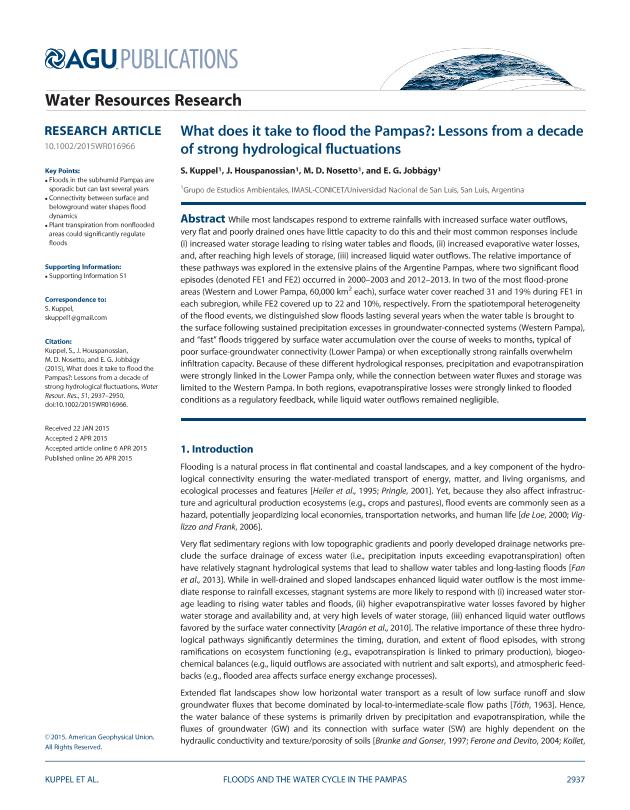Artículo
What does it take to flood the Pampas?: Lessons from a decade of strong hydrological fluctuations
Fecha de publicación:
03/2015
Editorial:
American Geophysical Union
Revista:
Water Resources Research
ISSN:
0043-1397
Idioma:
Inglés
Tipo de recurso:
Artículo publicado
Clasificación temática:
Resumen
While most landscapes respond to extreme rainfalls with increased surface water outflows, very flat and poorly drained ones have little capacity to do this and their most common responses include (i) increased water storage leading to rising water tables and floods, (ii) increased evaporative water losses, and, after reaching high levels of storage, (iii) increased liquid water outflows. The relative importance of these pathways was explored in the extensive plains of the Argentine Pampas, where two significant flood episodes (denoted FE1 and FE2) occurred in 2000?2003 and 2012?2013. In two of the most flood-prone areas (Western and Lower Pampa, 60,000 km2 each), surface water cover reached 31 and 19% during FE1 in each subregion, while FE2 covered up to 22 and 10%, respectively. From the spatiotemporal heterogeneity of the flood events, we distinguished slow floods lasting several years when the water table is brought to the surface following sustained precipitation excesses in groundwater-connected systems (Western Pampa), and ?fast? floods triggered by surface water accumulation over the course of weeks to months, typical of poor surface-groundwater connectivity (Lower Pampa) or when exceptionally strong rainfalls overwhelm infiltration capacity. Because of these different hydrological responses, precipitation and evapotranspiration were strongly linked in the Lower Pampa only, while the connection between water fluxes and storage was limited to the Western Pampa. In both regions, evapotranspirative losses were strongly linked to flooded conditions as a regulatory feedback, while liquid water outflows remained negligible.
Palabras clave:
Floods
,
Water Storage
,
Regional Water Cycle
,
Hyperplains
,
Groundwater
Archivos asociados
Licencia
Identificadores
Colecciones
Articulos(IMASL)
Articulos de INST. DE MATEMATICA APLICADA DE SAN LUIS
Articulos de INST. DE MATEMATICA APLICADA DE SAN LUIS
Citación
Kuppel, Sylvain; Houspanossian, Javier; Nosetto, Marcelo Daniel; Jobbagy Gampel, Esteban Gabriel; What does it take to flood the Pampas?: Lessons from a decade of strong hydrological fluctuations; American Geophysical Union; Water Resources Research; 51; 4; 3-2015; 2937-2950
Compartir
Altmétricas




